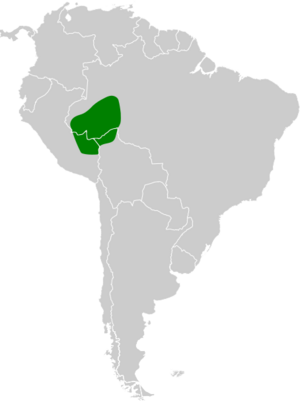Semicollared puffbird facts for kids
Quick facts for kids Semicollared puffbird |
|
|---|---|
| Conservation status | |
| Scientific classification | |
| Genus: |
Malacoptila
|
| Species: |
semicincta
|
 |
|
The semicollared puffbird is a small bird that lives in the forests of South America. It is part of the puffbird family, which includes birds like nunlets and nunbirds. You can find this bird in countries like Bolivia, Brazil, and Peru.
Contents
About the Semicollared Puffbird
The semicollared puffbird is a unique bird. Scientists have given it the name Malacoptila semicincta. It is closely related to another bird called the white-chested puffbird.
What Does It Look Like?
The semicollared puffbird is about 18 centimeters (7 inches) long. It weighs around 44 grams (1.5 ounces). Its head and upper body are dark brownish-black. Light streaks on its feathers make it look striped. Its tail is brown.
This bird has a white "whisker" mark near its beak and a white chin. It also has a thin white crescent shape across its upper chest. The back of its neck has a reddish-brown "collar." Its belly is whitish with dark streaks on the lower chest. The top part of its beak is black, and the bottom part is yellow-orange. It has dark red eyes with a white ring around them. Its feet are a pale greenish-pink color.
Where Does It Live?
The semicollared puffbird lives in western Amazonia. This area includes parts of western Brazil, southeastern Peru, and northern Bolivia. It prefers to live in forests where different types of trees meet. It also likes the edges of humid tropical forests. You can usually find it in the lower parts of the forest, from the ground up to the middle branches. It lives at elevations from sea level up to about 1,050 meters (3,440 feet).
How Does It Behave?
What Does It Eat?
Scientists do not know much about what the semicollared puffbird eats. They also do not know how it finds its food.
Reproduction and Life Cycle
Not much is known about how the semicollared puffbird raises its young. Its breeding habits have not been studied in detail.
What Does Its Song Sound Like?
The semicollared puffbird's song is a series of thin, high-pitched whistles. They sound a bit sad. Each whistle starts on the same note. Then, the sound drops in pitch. People describe it as "Fééeur" or "pseuu-uuu-uuu."
Is It Endangered?
The IUCN (International Union for Conservation of Nature) has listed the semicollared puffbird as "Least Concern." This means it is not currently in danger of disappearing. However, its total population size is unknown. Scientists believe its numbers might be going down. It lives in at least one protected area in Peru.


